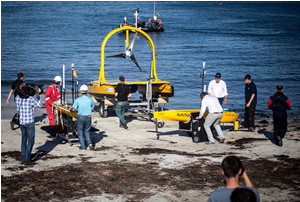Preparations underway for Phase Two
Preparations are well underway for Phase Two of the Exploring Ocean Fronts project, which sees the innovative ocean robots being used to track fish, as well as continuing to monitor the ocean itself.
 In a pioneering deployment, three of the autonomous vehicles – AutoNaut, C-Enduro and the SV3 Waveglider – will be launched off Plymouth early next week and will be used to track dozens of fish which are being released into the sea by a team at the Marine Biological Association (MBA).
In a pioneering deployment, three of the autonomous vehicles – AutoNaut, C-Enduro and the SV3 Waveglider – will be launched off Plymouth early next week and will be used to track dozens of fish which are being released into the sea by a team at the Marine Biological Association (MBA).
The vehicles, which are all carrying a range of sensors, will patrol a large area of water and work in conjunction with six acoustic sensors which have been fixed to the seabed. These activities are taking place in and around new Marine Protected Areas, to assess how fish use these areas on a day-to-day basis.
Plaice, sole, brill, turbot and rays have all been fitted with acoustic tags, which enable them to be tracked out at sea by both the ocean robots and seabed listening stations. The robots will be able to track a wider area than the static devices alone and will be continuing to collect additional data on the physical properties of the ocean, such as water temperature and salinity. On-board GoPro cameras will also capture valuable photographs and video footage of seabirds and other marine life.
The second phase of the project is expected to last until mid-November and follows the highly successful first phase, which saw five marine robots travelling for hundreds of kilometres off the Isles of Scilly to collect ocean and meteorological data.
The two-phase project is the largest deployment of marine autonomous systems ever seen in the UK and will provide valuable information about the shelf seas, marine life and the scope for autonomous vehicles in future research projects.
